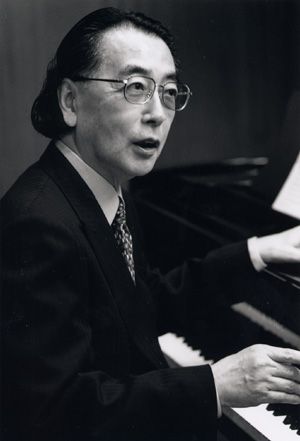Toshi Ichiyanagi facts for kids
Quick facts for kids
Toshi Ichiyanagi
|
|
|---|---|
| 一柳 慧 | |
 |
|
| Born | 4 February 1933 |
| Died | 7 October 2022 (aged 89) |
| Nationality | Japanese |
| Occupation | Composer Pianist |
| Years active | 1954–2008 |
|
Notable work
|
Kaika |
| Spouse(s) | |
Toshi Ichiyanagi (一柳 慧, Ichiyanagi Toshi, 4 February 1933 – 7 October 2022) was a Japanese composer and pianist. He was known for his very modern and experimental music. He was one of the most important composers in Japan after World War II.
Ichiyanagi wrote many different kinds of music. He created Western-style operas, music for orchestras, and chamber music. He also wrote pieces using traditional Japanese instruments. He was famous for using new and unusual techniques in his music. For example, he used "chance music," where some parts of the music are left up to chance. He was married to the famous artist Yoko Ono from 1956 to 1962.
Contents
Early Life and Learning
Toshi Ichiyanagi was born in Kobe, Japan, on February 4, 1933. He learned how to compose music from teachers like Tomojirō Ikenouchi and John Cage. John Cage was a very famous American composer known for his experimental music.
From 1954 to 1960, Ichiyanagi lived in New York City. While there, he studied at the Juilliard School and the New School for Social Research. These are both well-known schools for music and learning.
Ichiyanagi was married to Yoko Ono from 1956 to 1962. Their marriage ended when Ichiyanagi decided to move back to Japan, but Yoko Ono stayed in New York. He chose to remain single for the rest of his life.
His Music Career
When Ichiyanagi returned to Japan in 1960, he started working with a group called the Neo-Dada Organizers. This group was interested in "anti-art," which meant they challenged traditional ideas about art.
Many of Ichiyanagi's early music pieces used "graphic notation." This is a way of writing music using pictures and symbols instead of traditional notes. Sapporo (1963) is a good example of this.
Another important early work was Kaiki (1960). This piece was special because it mixed Japanese instruments like the shō (a type of mouth organ) and koto (a stringed instrument) with Western instruments like the harmonica and saxophone.
In his piece Distance (1961), musicians had to play their instruments from three meters away! For Anima 7 (1964), the instructions said to perform an action "as slowly as possible." These examples show how experimental and creative he was.
In 1963, Ichiyanagi helped start a new music group called New Direction. This group included other experimental composers like Takehisa Kosugi and Yuji Takahashi. The group broke up in the late 1960s when most members moved to New York, but Ichiyanagi stayed in Japan.
Later in his career, Ichiyanagi's music became a bit more traditional. He started writing more symphonies, operas, and concertos. He received many important awards for his work. These included the Suntory Music Award in 2001 and the John Cage Award in 2018. He was also honored with Japan's Order of Culture, which is a very high award.
Later Life and Passing
Toshi Ichiyanagi passed away on October 7, 2022. He was 89 years old.
Main Works
Toshi Ichiyanagi created a huge number of musical pieces throughout his life. Here are some of the types of works he composed:
Operas
He wrote several operas, which are plays set to music. Some of his operas include Hiraizumi Enjo (1989) and Momo (1995/98).
Orchestral Music
Ichiyanagi composed many pieces for full orchestras. These often featured solo instruments playing with the orchestra, like in his Piano Concertos (he wrote six of them!) and his Violin Concerto. He also wrote several symphonies, which are large-scale musical works for orchestra.
Chamber Music
Chamber music is written for a small group of instruments, usually one player per part. Ichiyanagi wrote many pieces for different combinations of instruments, such as string quartets (for four string instruments) and duets for piano and other instruments. He often mixed traditional Japanese instruments with Western ones in these pieces.
Music for Keyboards
He wrote a lot of music for piano and organ. Some of his piano works include a series called Music for Piano No. 1 – No. 7 and a long series called Cloud Atlas I–X.
Music for Other Instruments
Ichiyanagi also composed pieces for single instruments, like the harp, marimba, flute, and violin.
Vocal Music
He wrote music for choirs and solo singers. These pieces often used interesting texts or themes.
Japanese Instrument Music
A special part of his work was music written specifically for traditional Japanese instruments. This included pieces for gagaku ensembles (ancient Japanese court music), koto, sho, and shakuhachi (a Japanese flute).
Electronic Music
Ichiyanagi was also a pioneer in electronic music. He created pieces using electronic sounds, synthesizers, and even sounds recorded from the environment. Music for Electric Metronomes (1960) is an early example of his electronic work.
Theater and Film Music
He created music for theater performances and happenings (unplanned artistic events). He also composed music for several films, including Farewell to the Summer Light (1968) and Heroic Purgatory (1970).

